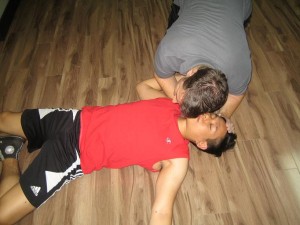There is no substitute for learning how to perform CPR, but tragedies don’t wait for training. These directions listed below are for conventional adult CPR. If you’ve never been taught CPR and the casualty passes out in front of you, perform hands-only CPR.
Here’s How:
- Try to wake the casualty up. If the casualty is not conscious (or is just panting for air), phone for an ambulance instantly and move to step 2. If somebody else is there to assist you, they can phone for an ambulance while you can move onto step 2 for the chest compressions.
- Start with chest compressions. If the casualty is unconscious, put the palm of your hand in the center of his chest. Place your other over the other hand with your fingers intertwined. Compress the chest at least 2 inches (4-5 cm). Leave the chest to fully recoil before starting with the next compression. Compress the chest at a speed of at least 100 pushes a minute. Do 30 chest thrusts at this speed (would probably take you approximately 18 seconds).
If you are not qualified in CPR, carry on to doing chest compressions till assistance arrives or the casualty regains consciousness.
It’s natural to feel cracks and snaps when you initially start chest compressions – DON’T STOP! The casualty won’t deteriorate – so continue with the compressions.
- Start with rescue breathing. If you have been taught in CPR, after 30 compressions, open the casualty’s airway by means of the head-tilt and chin-lift approach. Squeeze the casualty’s nose and form a seal over the casualty’s mouth with yours. Make use of a CPR cover if you have one available. Offer the casualty a breath large enough to make the chest increase. Let the chest decrease, then replicate the rescue breath again. If the chest doesn’t increase on the initial breath, shift the casualty’s head and try again. Irrespective of whether it works on the second attempt or not, move on to step 4.
If you don’t feel at ease with this step, just carry on doing chest compressions at a speed of at least 100 per minute.

Additional CPR Steps
- Perform chest compressions again. Do 30 more chest thrusts just like you did initially.
- Do more rescue breaths. Offer 2 more breaths like you did in step 3 (except if you decided to skip the rescue breaths).
- Keep going. Redo steps 4 and 5 for approximately two minutes (5 sets of 30 compressions and 2 rescue breaths).
If you have an automated external defibrillator (AED) at your disposal, carry on doing CPR till you can attach it to the casualty and switch it on. If you saw the casualty collapse, place the AED on straight away. If not, set it up after about one minute of CPR. After 2 minutes of chest compressions and rescue breaths, end the compressions and check to see if the casualty is conscious. If the casualty is still unconsciousness, carry on with CPR beginning with chest compressions.
- Redo the procedure, examining for breathing every 2 minutes, until assistance arrives. If the casualty wakes up, you can discontinue the CPR.
